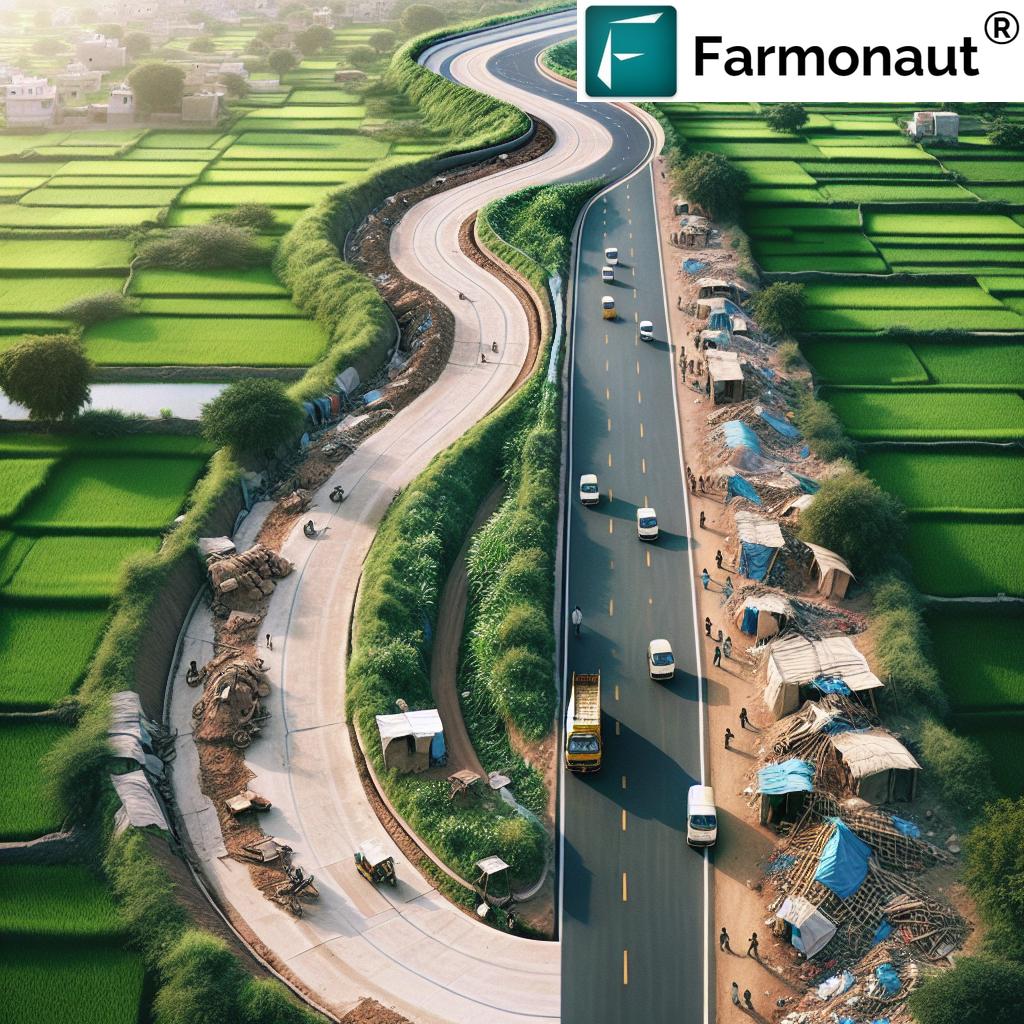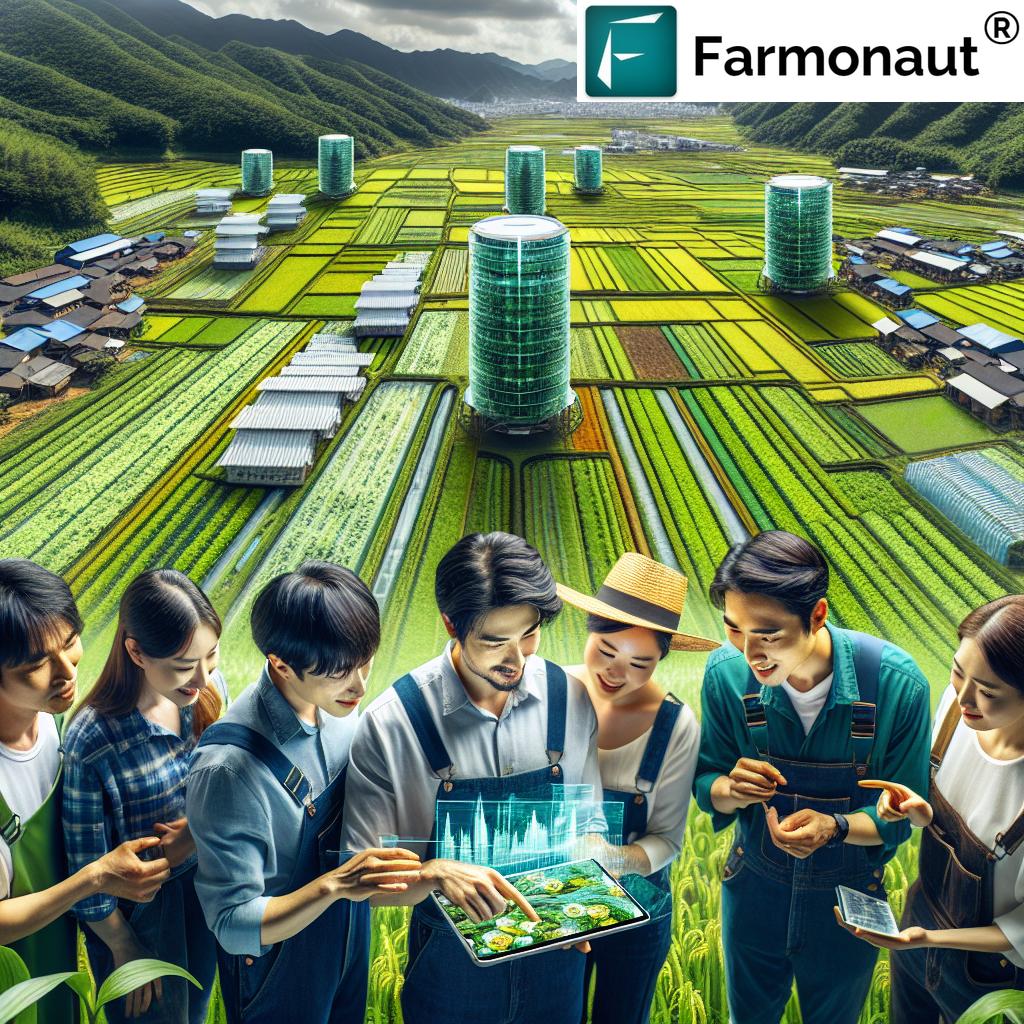Agriculture of Malaysia: Top Trends and Innovations for 2025
Table of Contents
- Agriculture in Malaysia: 2025 Overview
- Profile & Importance of Malaysian Agriculture
- Key Challenges in the Agriculture of Malaysia Sector
- Latest Trends and Innovations in Malaysian Agriculture
- Digital Technologies & Smart Farming in Malaysia
- Revolutionizing Crop Monitoring: Satellite Solutions by Farmonaut
- Sustainability and Climate Resilience in Malaysian Agriculture
- Government Policies and Agricultural Sector Development
- Comparative Table: Trends, Impacts & Challenges (2025)
- Future Outlook: Malaysian Agriculture 2025 & Beyond
- FAQs: Agriculture of Malaysia in 2025
“Malaysia’s agriculture sector is projected to grow by 4.2% in 2025, driven by sustainable innovations and digital technologies.”
Agriculture in Malaysia: 2025 Overview
The agriculture of Malaysia is entering an era of remarkable transformation. As we approach 2025, the sector remains a cornerstone of the national economy, contributing around 7-8% to Malaysia’s GDP and employing 10-15% of the workforce, predominantly in rural areas. The sector is adapting to challenges such as urban expansion, climate change, and global market shifts, while also seizing new opportunities through sustainability and digital innovation.
The biggest trends shaping Malaysian agriculture include the adoption of precision farming, increased emphasis on environmental sustainability, and broader integration of cutting-edge technologies like IoT, AI, blockchain, and satellite imagery. This article provides a comprehensive overview of the current state, key innovations, challenges, and the promising outlook for 2025 and beyond.
Profile & Importance of Malaysian Agriculture
Malaysia’s agricultural sector contributes significantly to the country’s economy and is vital for food security, especially in rural communities. The main products include palm oil, rubber, cocoa, rice, a wide variety of fruits (such as durian, rambutan, papaya), vegetables, and spices.
Palm Oil: The Dominant Commodity
Palm oil is Malaysia’s dominant export commodity, a critical source of foreign exchange and a key pillar of the country’s economic standing. Malaysia ranks as one of the world’s top producers and exporters of palm oil, alongside Indonesia, making the sector globally significant.
Rice, Fruits, Vegetables, and Diversification
Rice cultivation stays vital for food security despite occupying a smaller land area compared to plantation crops. The government provides substantial support to achieve near self-sufficiency.
Other prominent subsectors include high-value fruits like durian and papaya, vegetables, and spices. Exports of these are increasingly favored due to strong trade ties within ASEAN and China, and domestic demand keeps these industries resilient.
Rubber, Cocoa, and Diversified Exports
Rubber and cocoa remain critical yet face volatility in global markets. These crops contribute to incomes for smallholders and large plantations, supporting rural livelihoods and export revenues.
“Over 70% of Malaysian farmers are expected to adopt precision agriculture techniques by 2025, enhancing sector productivity.”
Key Challenges in the Agriculture of Malaysia Sector
Despite Malaysia’s significant agricultural strengths, the sector faces multifaceted challenges that must be addressed for sustainable growth in 2025 and beyond:
- Land Availability & Urbanization: Rapid urban expansion and industrialization are converting fertile land for non-agricultural projects, reducing the areas available for productive farming.
- Labor Shortages: Aging rural populations, migration of youth to cities, and foreign worker restrictions compound labor issues, making it harder for farmers to maintain yields and adopt better management practices.
- Climate Change: Increasingly erratic rainfall, frequent droughts, and extreme weather events impacts growing seasons, soil health, and productivity. Sustainable land management to prevent erosion is becoming even more critical.
- Commodity Market Volatility: Fluctuations in global market prices, especially for palm oil and rubber, directly affect farmers’ incomes, investment, and rural resilience.
- Traditional Farming Methods: Many smallholders still rely on traditional practices, limiting yields and making it challenging to meet domestic and export market demand.
- Access to Finance & Technology: Smallholders in particular often lack access to affordable finance, state-of-the-art technology, and reliable infrastructure for storing and transporting goods.
Latest Trends and Innovations in Malaysian Agriculture for 2025
Malaysian agriculture in 2025 is characterized by a strong focus on sustainability and technological adoption. Let’s explore the major trends and innovations shaping the sector:
- Precision Agriculture: Smart implements using GPS, drones, sensors, and AI analytics to monitor crops, optimize watering/fertilizer schedules, and minimize waste. Adoption rates are rising rapidly due to government support and a younger, tech-savvy generation of farmers.
- Integrated Farming Systems: Mixing crop and livestock farming to maximize land use, diversity incomes, and naturally regenerate soil and ecosystem health.
- Agroforestry & Regenerative Agriculture: Incorporating trees with crops (agroforestry) and regenerative techniques to enhance carbon sequestration, soil vitality, and biodiversity. These sustainable practices help in building climate resilience.
- Organic Farming: Investment in organic produce to meet increasingly strong demand both domestically and abroad, especially within health-conscious consumer segments.
- Sustainability Certifications: Palm oil and other major commodities are adopting RSPO and zero-burning initiatives to address environmental impacts and market demands for traceable, responsible products. (Learn more about blockchain-based traceability solutions that help guarantee integrity across supply chains.)
Digital Technologies & Smart Farming in Malaysia
The digital revolution in the agriculture of Malaysia is underway. Satellite technology, remote sensing, IoT sensors, and AI-powered platforms are transforming the way farmers manage land and resources. The adoption of these smart technologies is expected to improve productivity, reduce costs, and empower both smallholders and large estates.
- Drones & IoT Sensors: Drones equipped with multispectral cameras can detect pest issues or nutrient deficiencies at early stages. IoT sensors collect real-time data on soil moisture, temperature, and weather.
- Data Analytics & Precision Management: Insights from big data help farmers streamline resource deployment, minimizing chemical and water usage and boosting yields sustainably.
- Mobile Apps & Platforms: Tools available via smartphones provide up-to-date advisory, weather forecasts, and even financial services for crop insurance and lending. Explore our Farmonaut mobile app for affordable, real-time satellite crop monitoring services, available on
 and
and  .
.
Satellite-based services especially help to manage plantation crops like palm oil—monitoring health, optimizing harvests, and detecting issues remotely. To learn more, check the platform at large-scale farm management solutions.
For seamless integration into agri-business systems, explore our Farmonaut API and Developer Documentation.
Revolutionizing Crop Monitoring: Satellite Solutions by Farmonaut
At Farmonaut, we strive to democratize access to high-precision satellite technology for the agriculture of Malaysia and beyond. Our solutions provide:
- Satellite-Based Monitoring: Multispectral images for assessing vegetation health (NDVI), real-time alerts for issues in oil palm, rubber, and other plantation crops.
- AI Advisory (Jeevn): Offers weather forecasts and actionable strategies for soils, yields, and resource management.
- Traceability: Blockchain-based traceability for ensuring the supply chain integrity of Malaysian exports like palm oil and fruits.
- Resource Management: Optimize fleet and machinery use for large plantations, maximizing operational efficiency and reducing environmental footprint.
- Environmental Impact Tracking: Real-time carbon footprinting solutions to help farmers and industry leaders monitor and improve sustainability efforts.
All these services are available via Android, iOS, web, and API platforms to empower every level of Malaysian agriculture.
Sustainability and Climate Resilience in Malaysian Agriculture
Sustainability is at the very center of the future agenda for Malaysian agriculture. The sector is increasingly embracing eco-friendly practices to mitigate negative impacts on the environment and boost long-term productivity.
- Zero-Burning Policies: Official bans on open burning help to reduce air pollution and greenhouse gas emissions associated with land clearing in oil palm and rubber plantations.
- Sustainable Certifications: Programs like RSPO drive ethical sourcing and sustainability, ensuring that commodity exports meet strict global standards.
- Carbon Sequestration & Soil Health: Modern carbon footprinting tools and regenerative methods are deployed to trap carbon in soils, revitalizing soil and enhancing productivity.
- Biodiversity Conservation: Agroforestry integrates trees into farming systems for greater ecosystem health.
Government Policies and Agricultural Sector Development
The Malaysian government recognizes the importance of the agriculture of Malaysia for both economic growth and food security. Key policies and frameworks for 2025 include:
- 12th Malaysia Plan & National Agrofood Policy 2.0: These provide a blueprint to address sectoral challenges, enhance productivity, encourage innovation, and guarantee environmental sustainability.
- Infrastructure & Rural Development: Upgrades to irrigation, rural connectivity, and post-harvest logistics foster more efficient market access and reduce spoilage.
- Capacity Building: Skills training, cooperatives, and financial incentives support smallholder farmers in adopting cutting-edge technology and more profitable practices.
- New Crop Development: The government is actively promoting high-value new crops tailored to global wellness and specialty markets, such as superfoods, herbs, and specialty tropical fruits.
For progressive financial services, explore satellite-based crop loan and insurance solutions that increase transparency, speed up approvals, and reduce fraud for Malaysian farmers and agribusinesses.
Comparative Table: Trends, Innovations, Impacts & Challenges in Malaysian Agriculture (2025)
| Trend/Innovation | Description | Estimated 2025 Impact | Associated Challenges |
|---|---|---|---|
| Smart Farming & Precision Tech | Integration of IoT, AI, sensors, and data-driven platforms in crop, soil, and fleet management. | Est. 15-25% increase in productivity, adoption among 70% of farmers. | Adoption cost, older farmer training, infrastructure gaps. |
| Sustainable Crop Management | Agroforestry, zero-burning, carbon sequestration, and ecological certifications in palm oil and others. | Improved soil, biodiversity; ROI realized in 2-5 years. |
Initial yield dips, costs of certification, compliance monitoring. |
| Satellite & Remote Sensing for Crop Monitoring | Real-time monitoring systems (like Farmonaut) to assess crop health, forecast weather, and optimize resource allocation. | Faster issue detection (disease/pests), yield improvements, better insurance claims. | Data literacy, coverage for smallholders, cloud cover/infrastructure reliability. |
| Mechanization & Automation | Drones, smart tractors, and automated harvesting for labor efficiency. | Reduced labor costs, higher efficiency in large plantations. | High initial investment, small farm scale limitations. |
| Organic & High-Value Crop Growth | Expansion into organic, herbal, and superfood crops for niche markets. | By 2025, a projected 10-12% rise in export value for certified produce. | Certification hurdles, consumer education, global competition. |
| Supply Chain Traceability (Blockchain) | End-to-end verification of food and commodity origins for compliance and market value. | Boost in export credibility and price premiums. | Onboarding stakeholders, tech integration on plantations. |
Future Outlook: Malaysian Agriculture 2025 & Beyond
The future of the agriculture of Malaysia hinges on a delicate balance between sustainability, productivity, and adaptability to global trends. As innovation takes center stage and government supports progressive policies, the sector is poised for strong, sustained growth despite challenges in climate, labor, and market volatility.
-
Is Malaysia on the path to sustainable and inclusive agricultural growth?
With a surge in precision farming, sustainability certifications, and digital integration, Malaysian agriculture is set to thrive both domestically and on the global stage. -
What role will technology play for smallholder farmers?
Affordable, scalable tools (like those from Farmonaut and similar platforms) will empower even the smallest farmers to access real-time monitoring, improved yields, and better market connections. -
Will climate resilience define success?
Absolutely—regenerative practices, carbon management, and adaptive policies will enhance food security and rural resilience.
FAQs: Agriculture of Malaysia in 2025
Q1: What are the main challenges facing the agriculture sector in Malaysia in 2025?
Key challenges include land availability due to urban expansion, labor shortages, climate change impacts, volatile global commodity prices, and the need for increased technological adoption at scale.
Q2: How is the Malaysian government supporting sustainable agriculture?
The government is implementing the 12th Malaysia Plan and National Agrofood Policy, enhancing rural development, supporting digital innovations, promoting sustainable land management, and investing in farmer capacity-building and infrastructure.
Q3: What agricultural products dominate Malaysia’s exports?
Palm oil is the dominant commodity, followed by rubber, cocoa, fruits (like durian, rambutan, papaya), vegetables, and spices. These have significant roles in global trade.
Q4: What does the future hold for smallholder farmers in Malaysia?
Smallholders will benefit from government support, affordable access to digital tools like satellite monitoring, financial incentives, and blockchain-based traceability, which improves transparency and access to premium markets.
Q5: Where can farmers access modern agricultural technologies?
Farmers can use platforms such as Farmonaut—accessible via Android and iOS apps—for real-time satellite insights, resource management, and more.
Q6: Is the focus on export or domestic food security?
Both. While Malaysia is a top global exporter of commodities like palm oil, rice and essential foods are prioritized for domestic food security and resilience.
Summary: Agriculture in Malaysia—Trends and Outlook for 2025
In conclusion, the agriculture of Malaysia remains central not just for exports like palm oil and rubber but also for food security, rural livelihoods, and sustainable national development. The sector is evolving rapidly, embracing cutting-edge technology, resilience against climate change, and policies that foster innovation, sustainability, and global competitiveness.
We at Farmonaut are committed to accelerating this transformation by making advanced satellite, AI, and blockchain solutions accessible to Malaysian farmers and agri-businesses, empowering them to navigate the dynamic agricultural landscape of 2025 and beyond.










